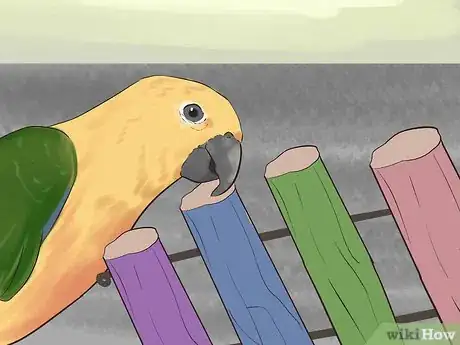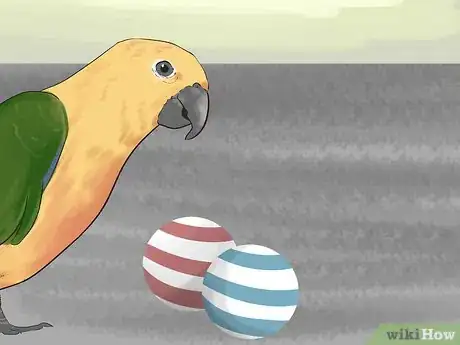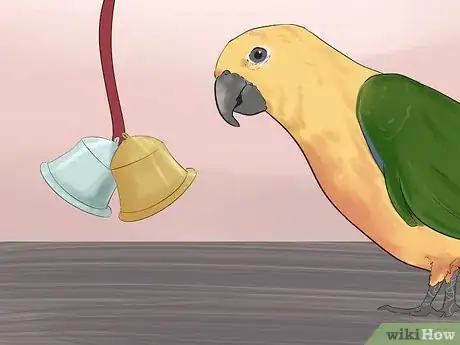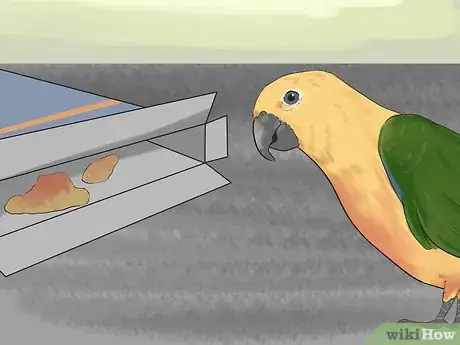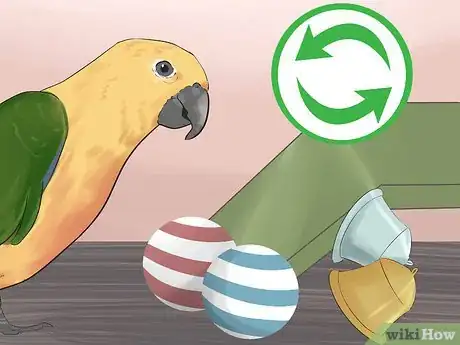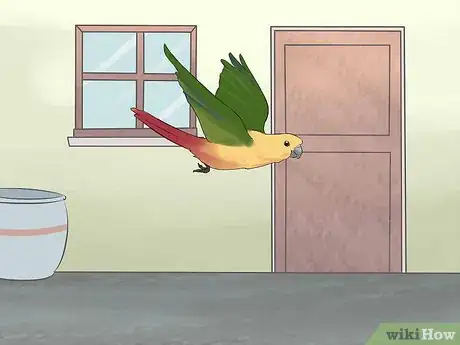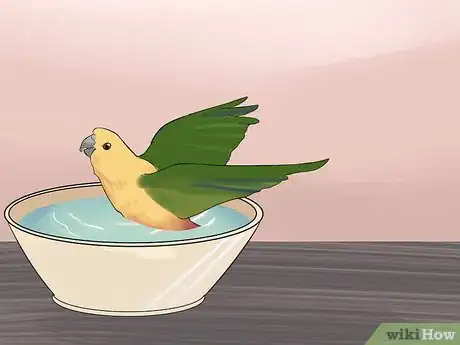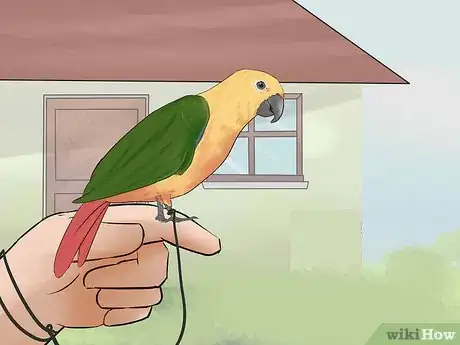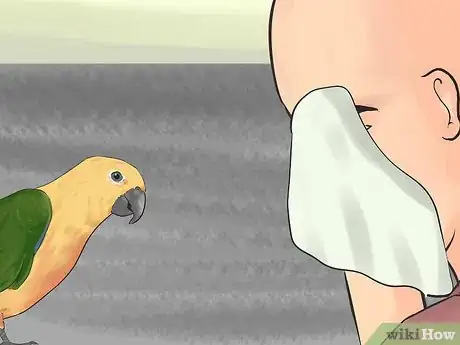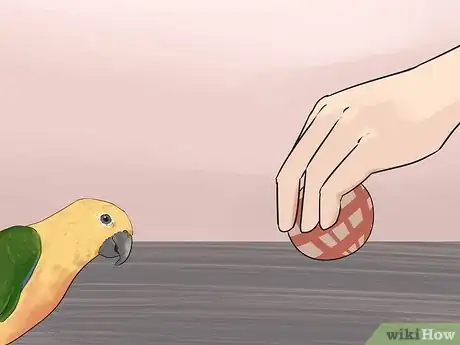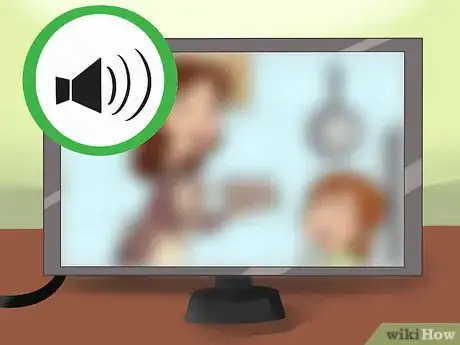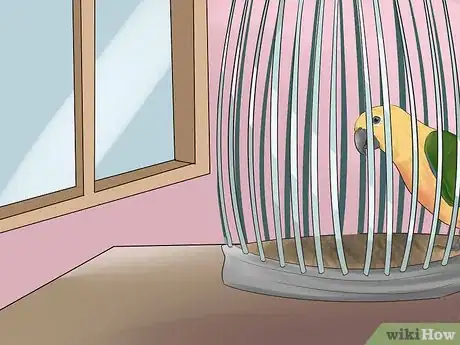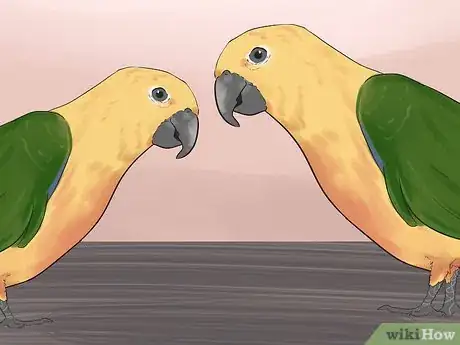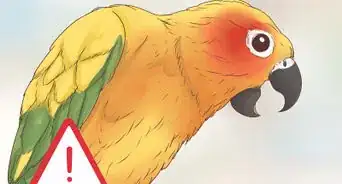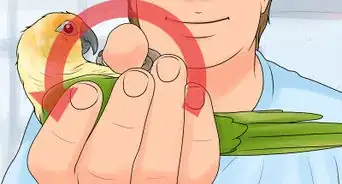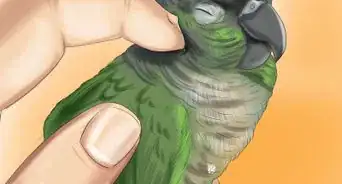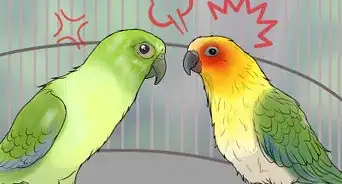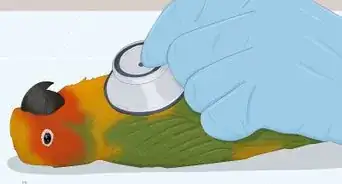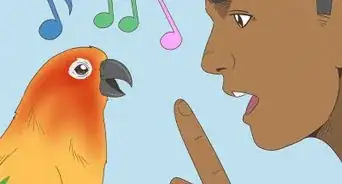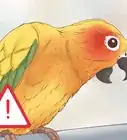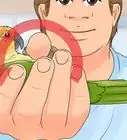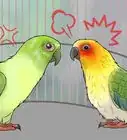This article was co-authored by Ryan Corrigan, LVT, VTS-EVN. Ryan Corrigan is a Licensed Veterinary Technician in California. She received her Bachelor of Science in Veterinary Technology from Purdue University in 2010. She is also a Member of the Academy of Equine Veterinary Nursing Technicians since 2011.
There are 12 references cited in this article, which can be found at the bottom of the page.
wikiHow marks an article as reader-approved once it receives enough positive feedback. In this case, 86% of readers who voted found the article helpful, earning it our reader-approved status.
This article has been viewed 48,456 times.
Conures may be one of the smaller varieties of parrots, but they have big personalities. To keep them entertained, conures need a variety of toys that they can shake, jangle, chew, and tear apart as well as plenty of time outside of their cage. While conures love to socialize, you can avoid boring them while you’re out of the house with some noise and interesting sights. Who knows? In the end, the conure may be the one entertaining you!
Steps
Giving the Conure Toys
-
1Give them something to chew. Good chew toys will keep your conure busy while sparing your furniture from their chewing. A conure should always have a few items to chew in their cage. Good chew toys include:[1]
- Wood blocks made out of balsa wood or pine
- Leather strips and ropes
- Vine balls
- Grass mats
- Wicker baskets
- Old books and newspapers
- Fruit and veggies (like carrots, celery, lettuce, and apples)
-
2Stick in some foot toys. Conures love playing with their feet. Try giving them a few toys that they can grip, turn, and kick. Wiffle balls, rattles, blocks with holes, and small wooden dumbbells are all great choices.[2]Advertisement
-
3
-
4Hide treats that they can find. Conures like foraging for food. Even if they’re happily fed, they will spend a long time hunting for hidden treats in their cage. Put sticks and branches with leaves in their enclosure and hide toys and treats among them to provide your bird with a natural environment to forage among. To keep them occupied, you can also hide treats and toys inside of:[5]
- Cereal boxes
- Rolled-up newspapers
- A drilled piece of wood
- Egg cartons
- Wreaths of grapevine or willow branches
- Finch nests
- Condiment cups filled with bird seed
-
5Rotate new and old toys. If your conure stops playing with their toys, it may be time to introduce new toys. Don’t throw out the old ones yet. Remove them from the cage until the conure grows tired of the new toys. You can then rotate in older toys. Your conure will play with the old toys as if they were new.
- If your conure is not playing with a new toy after a day or two, take it out and try again another day.
- If the toy is dirty or sticky from use, it may be helpful to clean and freshen it up to make it attractive again to your conure.
Playing with Your Conure
-
1Let them roam around your home. Conures will enjoy a chance to spread their wings and explore your home. They may even come hang out with you for a while. Give the conure at least an hour outside of their cage every day.[6]
- Always supervise your conure when they are out of their cage so they don’t get into trouble!
- Make sure to bird-proof your home before letting them roam. Close all windows, and turn off any fans. There should be no electrical wires or scented candles out in the open.[7]
- Always supervise your conure around other pets and children. If your other pets are aggressive toward small animals, put them in a separate room.
-
2Bathe your conure. Conures love a good bath every couple of days. Fill a tub with water, and place the bird in it. Once in the water, the conure will bathe themselves. If they don’t, splash the water to encourage them. When they are done, wrap them in a towel, and pat them dry gently.[8]
- You can use Tupperware containers or dog dishes to bathe your conure. The dish should be big enough that they can walk around comfortably in it.[9]
- If they don't want to bathe, take them out and try again another day.
-
3Walk them outside while restrained. Going outside can be fun for your bird. To prevent them from flying off, however, they must be restrained. Place the conure in a harness, and let them ride on your shoulder while you hold onto their leash. You can also carry them in a bird carrier.[10]
- If this is their first time outdoors, they may be nervous. Keep the first visit short.
- Even if their wings are clipped, a conure may still be able to escape outside. Always use a harness and leash or a bird carrier while outside.
- Spend time on a screened porch, if possible. This can help your conure get used to being outdoors and also provide them with fresh air without risking losing your bird.
-
4Play peekaboo with them. Just like children, conures love peekaboo. Hide your face behind a corner or an object. Let your conure come and find you. Pop out and say, “peekaboo!” Soon, your bird may be the one trying to hide.[11]
-
5Catch a ball with them. If your bird likes to toss items, catch can be a great game to play. Roll a plastic ball towards your bird. They may pick it up and toss it. Retrieve the ball, and roll it back to them. Keep playing until your bird gets bored.[12]
- Depending on your bird’s size, balls you can use include ping pong balls, small caged pet toy balls, golf-ball-sized rope balls, and bird-sized Jolly Balls.
Avoiding Loneliness When You're Gone
-
1Leave the TV or radio on. Some background noise can help make your bird feel more comfortable while they are alone. You can leave on a nature documentary, classical music, or a talk radio show.[13]
-
2Place the cage near a window. Position their cage near an open window where they can look outside. Make sure to keep the blinds or curtains open. The conure may enjoy watching other birds or people wander by the window.[14]
- Monitor the amount of heat and sunlight that the cage gets when near a window to prevent your conure from overheating while you are gone.
-
3Get them another bird as a companion. Conures are generally social birds. They may enjoy hanging out around other conures and occasionally even other types of parrots. The birds can keep each other company while you are gone.
- Make sure to choose a bird that has a compatible personality with your conure.
Warnings
- Conures are known to nip. If you are bitten, simply stand up and walk away from the bird. If your bird is out, return it to its cage and do not give it any attention or other forms of rewards.⧼thumbs_response⧽
References
- ↑ http://www.parrotenrichment.com/toys.html
- ↑ https://books.google.com/books?id=ekOc0gUPRpoC&lpg=PA16&dq=conure&pg=PA41#v=onepage&q=play&f=false
- ↑ https://www.petcha.com/conures-love-to-play/
- ↑ http://www.parrotenrichment.com/noisy-toys.html
- ↑ https://www.beautyofbirds.com/foragingtoys.html
- ↑ http://www.theparrotsocietyuk.org/pet-parrots/a-complete-beginners-guide
- ↑ https://www.beautyofbirds.com/birdproofingyourhome.html
- ↑ http://www.petparrots101.com/conures.asp
- ↑ http://gcch.tripod.com/faq/faq5.html
- ↑ https://journals.tdl.org/watchbird/index.php/watchbird/article/view/1689
- ↑ https://books.google.com/books?id=ekOc0gUPRpoC&lpg=PA16&dq=conure&pg=PA42#v=onepage&q=play&f=false
- ↑ https://books.google.com/books?id=ekOc0gUPRpoC&lpg=PA16&dq=conure&pg=PA42#v=onepage&q=play&f=false
- ↑ https://www.beautyofbirds.com/environmentalenrichment.html
- ↑ https://www.beautyofbirds.com/environmentalenrichment.html
About This Article
One way to entertain a conure is to let it out of its cage to explore your home for at least 1 hour a day so it can spread its wings. Before you do this, close any windows, put away electrical wires, and turn off any fans to keep it safe. While it's exploring, play peekaboo by hiding your face behind a cushion and saying “Peekaboo!” when it finds you. You can also play catch with your bird by rolling a plastic ping pong ball towards it and waiting for it to pick it up and toss it back. Every couple of days, you can give it a bath by filling a Tupperware container with warm water and placing your bird in it, since conures love bathing. For more advice from our Veterinary co-author, including how to keep your conure entertained when you’re not home, keep reading!
